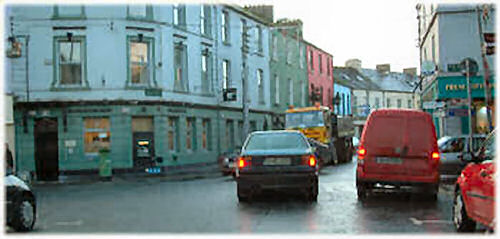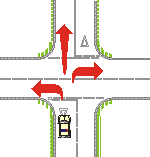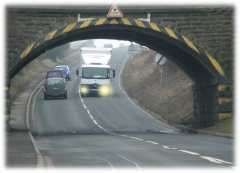Teaching crossroads - general information
 It's important to take every opportunity that is available to you to highlight the skills needed at crossroads during an initial crossroads lesson.
It's important to take every opportunity that is available to you to highlight the skills needed at crossroads during an initial crossroads lesson.
The main difference between crossroads and other junctions is that there is an extra road to think about, therefore the main skill difference that you will be emphasising is that of observation.
If you choose this lesson for your exam, your first opportunity to discuss 'crossroad skills' will be emerging from the car park.
If you are lucky there will be a Gateway or other opening on the opposite side of the road. If not there may be parked vehicles or perhaps pedestrians.
If doing this on an exam be prepared to take control of the situation as you emerge from the car park making sure that your learner looks clearly to the right and left, you can do this by direct instruction or by asking questions based on their previous knowledge, for example:
"You covered emerging from T-junctions last lesson, so where you need to look to ensure that we can emerge safely?"
Even though any learner who is skilled enough to drive the car from the test centre will be skilled enough to emerge safely, they might not drive as you expect when there is an examiner in the back!
In addition to this bring in the crossroad skills...
"If this were a crossroad we would also need to be checking ahead (instructor points). A car might emerge or turn into the Gateway in front of us, the pedestrians opposite might decide to cross the road. Checking these things is the same as using your observation skills at crossroads."
The first crossroad
If you have demonstrated and or explained the method for observation shown on the next page there is a good chance that your learners will get the first crossroad right without any input from you. Remember that they will have already mastered approaching and emerging at other junctions before doing this lesson. However, be prepared to ask question or prompt if required.
 Remember that the lesson is about teaching your pupil to enter crossroads and leave at different destinations; this means that if you cover two or three left turns successfully it doesn't mean that the right turns or driving ahead will be equally successful.
Remember that the lesson is about teaching your pupil to enter crossroads and leave at different destinations; this means that if you cover two or three left turns successfully it doesn't mean that the right turns or driving ahead will be equally successful.
The most common instructional error is probably to pay too much attention to the road and not enough attention to the learner when arriving at the crossroads. (See the Watching the Learner section)
Nearside or offside passing
Many students (and some instructors!) get a bit confused when it comes to 'nearside' or 'offside' passing at crossroads. NEVER try to explain this rule without a diagram! See examples on the DriverActive Crossroads page - Turning Right information.
Offside-to-offside passing might be the safest way to deal with junctions, however, at many junctions there is not enough space to allow this and those that do have enough space often have a high volume of traffic which makes offside passing impractical. Offside passing can also confuse other drivers. Make it clear that whichever method of passing is chosen at a particular junction it is essential that for observation is made and that other drivers are clearly aware of your intentions.
Flashing headlights
 Crossroads offer an ideal opportunity to discuss flashing headlights as people will often give way.
Crossroads offer an ideal opportunity to discuss flashing headlights as people will often give way.
If this happens be prepared to take control immediately, if the situation develops before you have an opportunity to act find the first available place to pull up and briefly explain the rules and dangers relating to flashing headlights.
If you have mixed feelings about the use of flashing headlights or simply wish to gain some ideas about how to explain the dangers take a look at the SmartDriving advice about headlamp flashing.
Next: Step 3 - Teaching the '1,2,3' method...